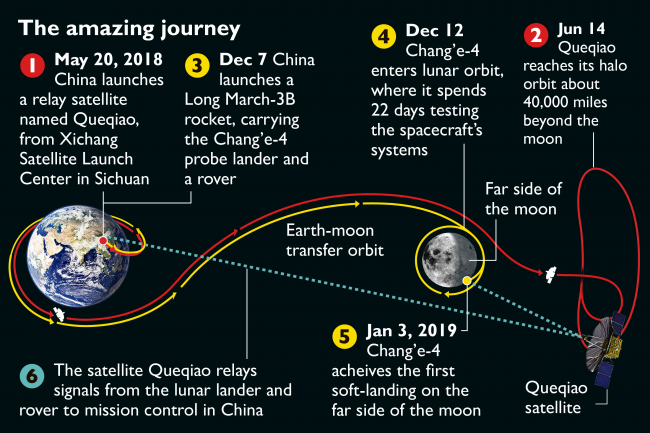Chang’E probe (CE-4) 21/05/2019 – Posted in: Daily News – Tags: changE-4, Formation of moon, Lunar Magma Ocean Theory, moon mission
Chang’E probe (CE-4)
Preliminary: About mission
Mains: CE-4, Formation of moon, Lunar Magma Ocean Theory
News Flash
Chinese spacecraft Chang’e-4 — named after the moon goddess in Chinese mythology — became the first ever craft to touch down on the far side of the lunar surface.
- Scientists have said they could be a step closer to solving the riddle behind the Moon’s formation, unveiling the most detailed survey yet of the far side of Earth’s satellite.
- Chang’e 4 is the fourth lunar probe launched by China since the country’s lunar programme was opened in 2004.
Moon’s formation
- The moon is believed to have gone through a phase during its formation when it was partially or entirely composed of molten rock.
- As it cooled, denser minerals sank to the bottom of the magma-ocean, while lighter materials gathered near the surface to form its mantle.
- The team detected materials such as olivine and low-calcium pyroxene that are rare elsewhere on the surface.
- These materials were ejected from the Moon’s upper mantle when it was struck by a meteor.
Lunar Magma Ocean Theory
- The lunar magma ocean (LMO) is a term used in planetary science to describe the thermal state of Earth’s Moon in the thousands to millions of years following its formation.
- The most widely accepted model for the formation of the Moon invokes a collision between proto-Earth and another proto-planet, often referred to as Theia.
- The Moon accreted from the resulting debris disk surrounding the Earth, which likely consisted of molten and vaporized silicate material.
- The accretion of the Moon from this debris disk leads to a body in a largely or completely molten state. This “magmasphere” is referred to as the LMO.
Source: LMO
Tasks of the Chang’e-4 mission include:
- Low-frequency radio astronomical observation
- Surveying the terrain and landforms.
- Detecting the mineral composition and shallow lunar surface structure.
- Measuring the neutron radiation and neutral atoms to study the environment on the far side of the moon.
Background
The first-ever soft landing is being seen as a major milestone in space exploration because unlike previous moon missions that have landed on the Earth-facing side, this is the first time any craft has landed on the unexplored and rugged far side of the moon.
- The successful landing formally inaugurated the world’s first expedition to the far side that never faces the Earth.
- Scientists around the world have not been able to conduct close observations and surveys of the region for decades
- It landed on the Von Karman crater in the South Pole-Aitken basin and then sent back a picture of the landing site shot by one of the monitor cameras on the probe’s lander, marking the world’s first image taken on the moon’s far side.
- Tidal forces on Earth slow the moon’s rotation to the point where the same side always faces Earth. The other side, most of which is never visible from Earth, is the far side of the moon.
- Direct communication with the far side of the moon, however, is not possible.
- China launched a relay satellite, named Queqiao, to set up a communication link between the Earth and Chang’e-4 lunar probe.
- This is the first time an attempt is made to explore the far side of the moon.
- Since the moon’s revolution cycle is the same as its rotation cycle, the same side always faces Earth.
- The far side of the moon is the hemisphere that never faces Earth, due to the moon’s rotation.
Source: The Hindu
You can follow us on LinkedIn and for more updates related to UPSC IAS Preparation, Like our Facebook Page and subscribe our Diligent IAS Youtube Channel
Also Read Related Daily News
- Global Drug Survey Report 2018
- Comprehensive Test Ban Treaty Organization
- Services Trade Restrictiveness Index (STRI)



